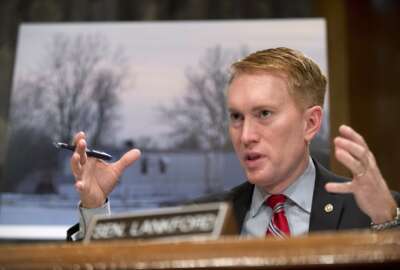Agencies find higher quality candidates under new Digital Service, OPM hiring pilot
The U.S. Digital Service said it sees promise in a new hiring pilot designed to better find and screen candidates who are truly qualified for the job, with help...
Best listening experience is on Chrome, Firefox or Safari. Subscribe to Federal Drive’s daily audio interviews on Apple Podcasts or PodcastOne.
Criticisms about the federal hiring process and USAJOBS.gov have ranged far and wide over the past decade or so, but federal managers have their own complaints too.
Just half of the positions for technical experts posted to USAJOBS lead to a new hire.
Many hiring managers often feel like the competitive process is a waste of time, especially when the long lists of “qualified candidates” aren’t actually truly qualified for the position at all.
It’s no wonder that federal hiring managers are turning to other strategies to fill vacancies — noncompetitively — with tools like direct hire authority or other exceptions.
And it’s why the U.S. Digital Service and the Office of Personnel Management have teamed up to “look under the hood” of the federal hiring process and pilot a new practice for agency hiring managers and subject matter experts to better assess applicants’ qualifications and skills.
The pilot, which OPM described in new federal hiring guidance given to agencies last month, is designed to use agency subject matter experts to evaluate and screen better qualified candidates, specifically for IT positions.
“Time is important, but if the quality of the list for hiring managers to select [from], isn’t high enough and you’re canceling certificates, the amount of time to get there doesn’t matter,” Stephanie Grosser, a “bureaucracy hacker” with the Digital Service, said Tuesday at an event with the National Academy of Public Administration. “You have to get the quality right and then speed that process up once you have a process that works.”
With that mindset, OPM and the Digital Service set out to arrange a new set of practices for agency human resources specialists, hiring managers and subject matter experts.
The new process first instructs agencies to select a handful of subject matter experts (SMEs) to help them screen candidates to a specific position. SMEs work with hiring managers to develop a job analysis with accurate competencies.
Then, the hiring process begins in earnest.
Under the new hiring pilot, no one is considered “qualified” until they pass through two structured interviews with agency subject matter experts. The interviews include questions tailored to the specific position and are designed to test the candidate’s competencies. Engineers could take a coding test, for example, instead of sitting through a formal interview, Grosser said.
Only once a candidate clears these interviews can the agency apply veterans preference, for example.
“This idea is not novel or innovative in any way, but if you tell this to someone in government, they’ll think it’s against the law,” Grosser said. “They’ll think they’ll get fired if they actually have a pass-fail examination where they can get out someone, even with veterans preference, at that stage. The point is preference and qualification is the same bar for everyone. You should only apply preference after someone is actually deemed qualified.”
Once preference is applied, an agency can then rate the candidates. Then, human resources specialists will prepare a list of qualified candidates for the agency hiring manager to choose from and make one or more selections.
In the past, it took hiring managers up to 47 days to make these selections. But under the new process, pilot agencies took between 11 and 16 days to choose from a list of qualified candidates.
Related Stories
In new batch of federal hiring advice, OPM urges agencies to review how they assess job candidates
About 165 people applied for an IT specialist GS-13, 2210-series position at HHS. Of those applicants, only 36 passed the interview phase and were considered “qualified,” Grosser said.
HHS made seven selections.
More than 220 people applied for a similar IT position at the National Park Service. Just 11% were considered “qualified.” The Park Service made 13 selections.
“Again, we applied veterans preference only at the end,” Grosser said. “Four veterans made it through the process. In both of these processes, federal employees made it through, contractors made it through, private sector applicants made it through, people under 30 made it through, women made it through [and] different racial groups made it through. There wasn’t an adverse impact to any group.”
Pilot shows promise for further hiring improvements
The new hiring pilot is a time commitment for the agency subject matter experts, who were first trained on merit system principles and practices related to fair and ethical hiring before conducting interviews.
But SMEs said it was all worth it once they knew their time and effort contributed to their agency’s ability to hire more qualified talent.
“We’ve been really heartened with the two pilots that we’ve run,” Matt Cutts, Digital Service administrator, told reporters Wednesday afternoon. “We’re looking at, as far as what’s next, how we can scale that up and talk about working with other agencies and also just making them aware that they are able to do this process themselves now.”
Grosser said the Digital Service is going on a “roadshow” to all 24 of the Chief Financial Officer Act agencies to teach them about the new hiring pilot.
These new practices aren’t mandatory. But for the Trump administration, the pilot proves it can find ways to more meaningfully improve the federal hiring process within the bounds of existing statute — and avoid getting Congress involved.
Latest Workforce News
The administration doesn’t buy into the premise that “we have to blow everything up” to create change, she added.
Meanwhile, agencies are currently determining what other positions could use this process. Grosser said agencies are considering the new practice for biologists, economists and HR specialists.
They’re also exploring how they could take the OPM hiring pilot to the next level.
USDS is working on an online compendium of sorts to collect hiring resources and position competencies that could inform other agencies’ work.
And for the next iteration of the pilot, the Digital Service and OPM are considering how agencies can continue to keep candidates who were considered “qualified” on their hiring managers’ certification lists for up to a year.
OMB acknowledged the hiring pilot is best suited for agencies looking to hire a group of people instead of a single person.
But the pilot should inspire government to rethink the way it hires large swaths of new talent altogether, Grosser said.
“Everyone can share their SMEs and share their vacancies and share these certificates,” she said. “If you have 20 people who qualify and have gone through this time intensive process, you’re not only hiring one of them and then 19 truly qualified people have to start over again. You could actually be smarter than that and more efficient with your time. Your goal can be if 20 people make it through this process, government is big enough that we should be able to place all 20 of them in government.”
Copyright © 2025 Federal News Network. All rights reserved. This website is not intended for users located within the European Economic Area.
Nicole Ogrysko is a reporter for Federal News Network focusing on the federal workforce and federal pay and benefits.
Follow @nogryskoWFED







